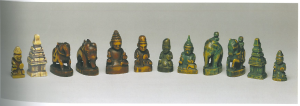I feel like this book is difficult to expand on, but was quite interesting. It’s really neat how the history and politics of each region chess reached changed it to more fit the history and culture of the area. But I almost feel that’s almost all you can say about it, as the notion that culture influences cultural product is hardly a difficult one to grasp or accept. Except for one thing, the fact that apparently people used chess as a major function of courtship, which I genuinely had no idea about prior to this reading.
I doubt I was the only one without that knowledge especially given the fact that Chess has taken on a completely separate, and almost opposed, symbology and iconography in our day and age. On top of that, the realization that Chess was a largely gender inclusive game, when nowadays its notable when women manage to break into the sport in a meaningful way. I think its not too far reaching to say that a lot of that change was due to the way games were being viewed in the modern and pre-modern era; largely as tools for didactic indoctrination or increasingly masculine sport, ala polo and football.
Both these points lead into ideas I feel we have been pointing at for a while. Really specifically that culture informs games whereupon games then inform culture. In that, the queen became an increasingly significant icon due to the increasing role queen’s and marriage were playing in European politics while the politics of play during this time greatly involved women and courtship, as opposed to its early iteration where it was informed by the culture of war, with its elephant and vizier, and reflected that waring culture with its popularity amongst generals.
I like this image a lot because it shows how timeless and important proper visual design is in regards to game design, as well as the juncture between game design and simulation. Every piece clearly depicts its would be role in an army, and these roles correlate to both the value and movement of the piece themselves. Horses are able to traverse easily and elaborately, elephants and rooks (ziggurats?) are powerful and important, etc. Because each piece shows its value in an army, it allows players to understand the function the serve within the game. As we move forward, it’s worth looking out for these kinds of relationships as game design will always be important for understanding how games function within society.

